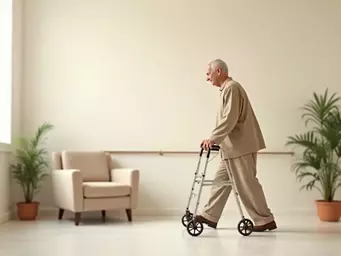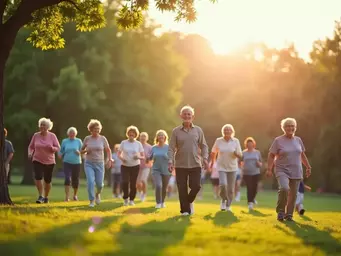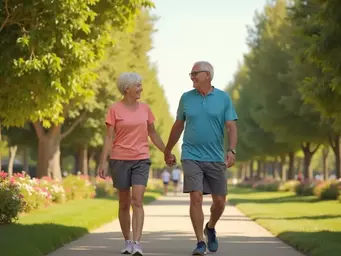Physical Activity Benefits for Seniors

What if a simple change in your daily routine could dramatically enhance your quality of life? Engaging in physical activity is a vital component of healthy aging, offering a multitude of benefits for seniors. Here, we unravel the importance of staying active and how it can transform lives.
Key Takeaways
- Physical Health Maintenance: Regular exercise supports strength, balance, and mobility, crucial for independence.
- Cognitive Protection: Engaging in physical activity reduces the risk of cognitive decline and dementia.
- Mood Enhancement: Physical activity can alleviate symptoms of depression and anxiety, fostering a positive mental state.
- Community Connection: Participating in group activities builds social bonds, reducing feelings of isolation among seniors.
- Empowerment through Education: Access to tailored resources helps seniors understand how to safely incorporate exercise into their lives.
- Supportive Environments: Community-led programs and policies play a vital role in creating safe spaces for seniors to be active.
- Actionable Steps: Starting small, setting realistic goals, and seeking support can significantly enhance engagement in physical activity.
Key Benefits of Physical Activity for Seniors
Physical activity offers numerous health benefits for seniors. Below is a visual representation of these key advantages.
Physical Health
Regular exercise helps maintain strength, balance, and mobility.
Cognitive Benefits
Physical activity is linked to a lower risk of cognitive decline and dementia.
Improved Mood
Regular movement can alleviate symptoms of depression and anxiety.
Social Connections
Group activities foster relationships, which are vital for emotional health.
Understanding the Importance of Physical Activity for Seniors
At Cairns Active Ageing Solutions, we believe that staying active is vital for seniors to maintain their independence and enhance their quality of life. Have you ever thought about how physical activity can impact your day-to-day experiences? From improving mood to increasing mobility, the benefits are numerous and significant!
Physical activity is not only about keeping fit; it’s also about feeling good, both physically and mentally. When seniors engage in regular movement, they often find themselves more energetic and happier. So, let's dive deeper into why this is so important!
Exploring Informational and Educational Intent
Many older adults actively seek information on physical activity because they want to improve their health and well-being. They may be curious about how much exercise is right for them or which types of activities are best suited for their abilities. At Cairns Active Ageing Solutions, we aim to provide clear, accessible information that helps seniors navigate these questions.
By understanding their needs, we can create tailored resources that offer practical solutions. This education can empower seniors to take charge of their health and engage in activities that promote a vibrant, active lifestyle.
Why Seniors Seek Information on Physical Activity
There are several reasons why seniors look for guidance on physical activity:
- Health concerns: Many are motivated by chronic conditions or the desire to prevent them.
- Desire for independence: Staying active can help maintain mobility and reduce the risk of falls.
- Social connections: Engaging in physical activity can foster relationships and community bonds.
- Improved quality of life: Seniors want to feel their best and enjoy life to the fullest!
Implications for Health Interventions and Policies
Effective health interventions and policies can significantly influence seniors' access to physical activity resources. Creating environments that promote movement can lead to better health outcomes. For example, community programs that offer exercise classes tailored for older adults can encourage participation and engagement.
Moreover, policies that support safe walking paths and accessible fitness spaces can further enhance opportunities for active living. We see our role at Cairns Active Ageing Solutions as vital in advocating for these changes, ensuring seniors have the support and resources they need.
Comprehensive Health Benefits of Physical Activity for Older Adults
Now, let’s explore the incredible health benefits that come from engaging in regular physical activity. These advantages extend beyond just the physical aspects and can truly enhance overall well-being. Staying active can lead to a healthier, happier life, as highlighted by the National Council on Aging's insights on the life-changing benefits of exercise after 60. As we work together to promote these insights, we can help seniors embrace the joys of movement!
Pro Tip
Did you know? Consistency is key when it comes to physical activity for seniors. Aim to incorporate at least 150 minutes of moderate-intensity aerobic activity, such as brisk walking, each week. This can be broken down into manageable 30-minute sessions, five days a week. The goal is to create a routine that feels enjoyable and sustainable, allowing you to reap the physical and mental benefits of regular movement.
Summarizing the Multifaceted Benefits of Physical Activity for Seniors
As we journey through life, the importance of staying active becomes increasingly clear. Regular physical activity is not just about maintaining physical health; it also plays a crucial role in boosting cognitive function and enhancing quality of life. For seniors, the benefits are multifaceted, ranging from improved mobility to better mental well-being. At Cairns Active Ageing Solutions, we strive to remind our community about these vital aspects of healthy aging!
When we think about the benefits of exercise, it’s essential to recognize how *physical* and *mental* health intertwine. Engaging in regular physical activity can lead to substantial improvements in both areas, creating a positive feedback loop that encourages a more vibrant life. By focusing on this holistic approach, we can better support seniors in their quest for a fulfilling and independent lifestyle.
Key Takeaways on Health, Cognition, and Quality of Life
To truly appreciate the impact of physical activity, let’s recap some key benefits:
- Physical Health: Regular exercise helps maintain strength, balance, and mobility, as emphasized by the CDC's guidelines on physical activity for older adults.
- Cognitive Benefits: Physical activity is linked to a lower risk of cognitive decline and dementia. The American College of Sports Medicine provides further details on the cognitive benefits of physical activity for older adults.
- Improved Mood: Regular movement can alleviate symptoms of depression and anxiety.
- Social Connections: Group activities foster relationships, which are vital for emotional health.
These benefits highlight the critical role that both *individual effort* and *community support* play in promoting active aging. Together, we can create a supportive environment where seniors can thrive.
Recap of Physical and Cognitive Benefits
It’s important to remember that staying physically active is a powerful tool for seniors. The combination of enhanced physical function and better mental clarity can lead to a more enjoyable daily life. Imagine walking with friends or engaging in fun group exercises! This camaraderie not only makes exercise enjoyable but also strengthens social bonds, which are crucial at any age.
Moreover, the positive effects on cognition—like improved memory and focus—can empower seniors to continue learning and engaging with the world around them. When we stay active, both physically and mentally, we pave the way for a more vibrant and fulfilling life!
Understanding the Role of Community in Physical Activity
Community plays a vital role in encouraging seniors to engage in physical activities. Here’s how:
- Supportive Environment: Local programs and classes tailored for seniors can provide a safe space for participation.
- Social Interaction: Group activities foster connections, reducing feelings of isolation.
- Shared Experiences: Learning from others' journeys encourages motivation and commitment.
At Cairns Active Ageing Solutions, we are committed to fostering such a community where seniors can find the resources they need to remain active and engaged. Together, we can help each other thrive!
Encouraging Active Lifestyles for Older Adults
To truly embrace the benefits of physical activity, it’s essential for seniors to take actionable steps towards incorporating exercise into their daily lives. Making small changes can lead to significant improvements over time. Let’s explore some practical steps together!
Actionable Steps for Seniors to Incorporate Exercise
Here are some simple yet effective ways to get started:
- Start Small: Begin with short walks or gentle stretching exercises to gauge comfort levels.
- Set Realistic Goals: Aim for achievable milestones, like walking a certain distance each week.
- Join a Class: Find local exercise classes tailored for seniors to build confidence and meet others.
- Ask for Help: Seek support from family, friends, or professionals to stay motivated.
These steps can help build a routine that feels manageable and enjoyable. Remember, every bit of movement counts!
Setting Realistic Goals and Expectations
Setting goals is an excellent way to stay motivated, but it’s essential to keep them realistic. Consider focusing on progress rather than perfection. For instance, if you aim to walk 20 minutes a day, you might want to start with 10 minutes and gradually increase. Celebrate each achievement, no matter how small—it all adds up!
Resources for Ongoing Support and Motivation
Finding resources that support your journey can make a world of difference. Here are some options to consider:
- Local Community Centers: Check for fitness programs designed for seniors.
- Online Platforms: Various websites offer virtual classes and exercise tips.
- Health Professionals: Consult with doctors or physical therapists for tailored advice.
At Cairns Active Ageing Solutions, we also provide valuable resources and guidance to help seniors stay active and engaged.
Fitness Assessments and Medicare Fitness Programs
Consider taking advantage of fitness assessments and Medicare fitness programs. They can guide you in creating a personalized exercise plan that considers your unique needs and health condition. This approach ensures that you are exercising safely and effectively, maximizing the benefits of physical activity.
Frequently Asked Questions (FAQs)
Q: Why is physical activity important for seniors?
A: Physical activity is crucial for seniors to maintain independence, improve physical and mental health, enhance cognitive function, and foster social connections. It helps reduce the risk of chronic conditions and improves overall quality of life.
Q: What are the key benefits of physical activity for older adults?
A: Key benefits include improved physical health (strength, balance, mobility), cognitive protection (lower risk of decline and dementia), enhanced mood (alleviating depression and anxiety), and stronger social connections.
Q: How much physical activity is recommended for seniors?
A: It is generally recommended that seniors aim for at least 150 minutes of moderate-intensity aerobic activity per week, which can be broken down into manageable sessions (e.g., 30 minutes, five days a week).
Q: What are some actionable steps seniors can take to incorporate exercise into their daily lives?
A: Seniors can start small, set realistic goals, join local exercise classes, and seek support from family, friends, or health professionals. Consistency and finding enjoyable activities are key.
Q: How can community programs support active aging?
A: Community programs provide supportive environments, opportunities for social interaction, and shared experiences, which can significantly motivate seniors to stay active and engaged.
Invitation to Engage
We invite you, as seniors and caregivers, to share your experiences with physical activity! What has worked for you? What challenges have you faced? Your stories can inspire others and create a supportive community where we uplift one another.
Encouraging Seniors and Caregivers to Share Their Experiences
Sharing personal journeys not only builds community but also helps us learn from each other. So, we encourage you to connect with others in our community. Join local forums, attend events, and engage in discussions—your insights could spark motivation in someone else!
Promoting Local Community Programs and Resources
Lastly, we encourage everyone to explore local community programs and resources available for seniors. These initiatives can provide valuable support in achieving a more active lifestyle. Together, we can foster a community that prioritizes health, connection, and active aging!
Recap of Key Points
Here is a quick recap of the important points discussed in the article:
- Health Benefits: Regular physical activity improves strength, balance, and mobility in seniors.
- Cognitive Improvement: Engaging in exercise can lower the risk of cognitive decline and dementia.
- Mood Enhancement: Physical activity can help alleviate symptoms of depression and anxiety.
- Social Engagement: Group activities foster social connections, reducing feelings of isolation.
- Community Support: Local programs and classes tailored for seniors create a supportive environment for active participation.
- Actionable Steps: Start small, set realistic goals, join community classes, and seek help to stay motivated.







